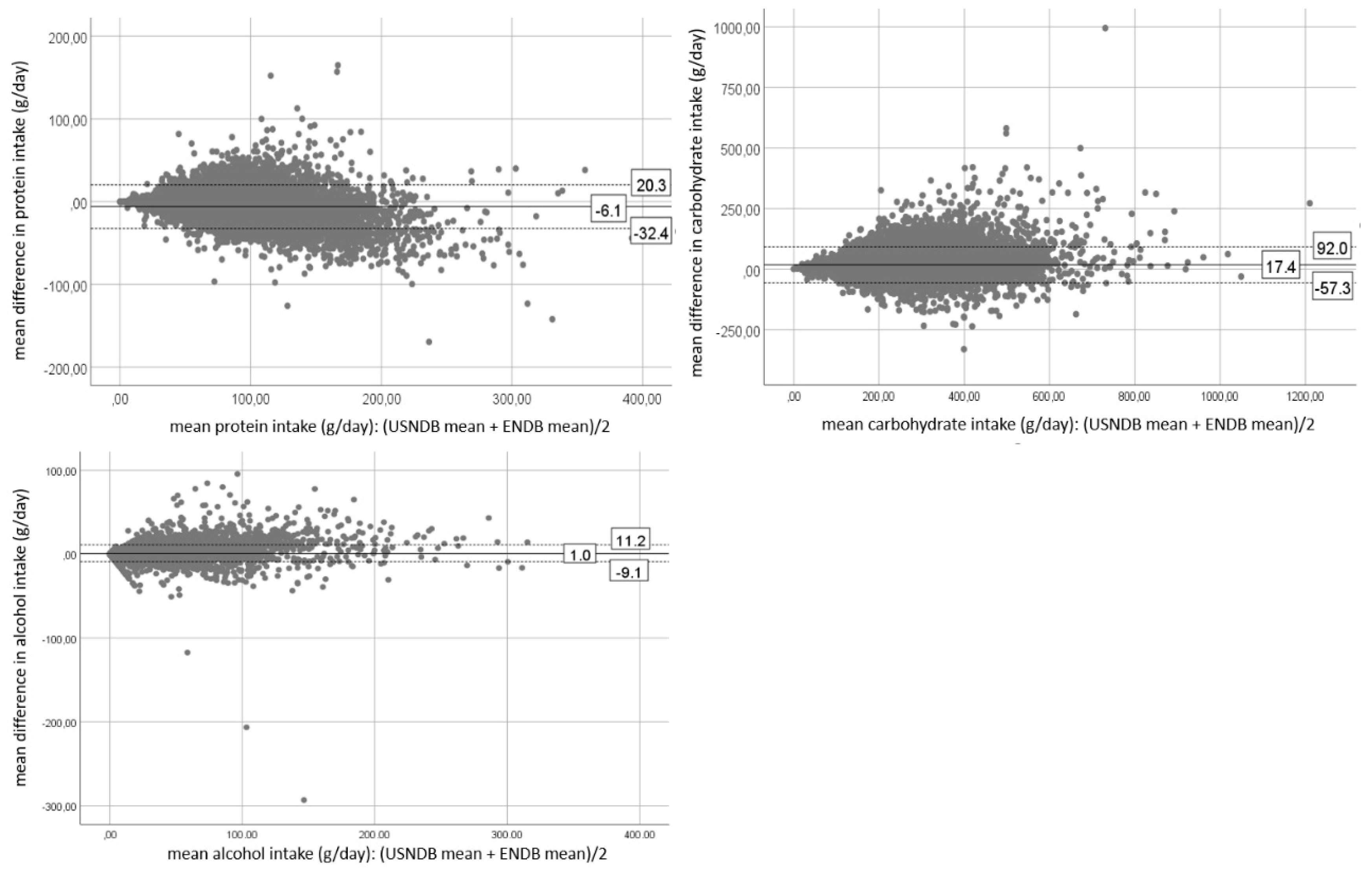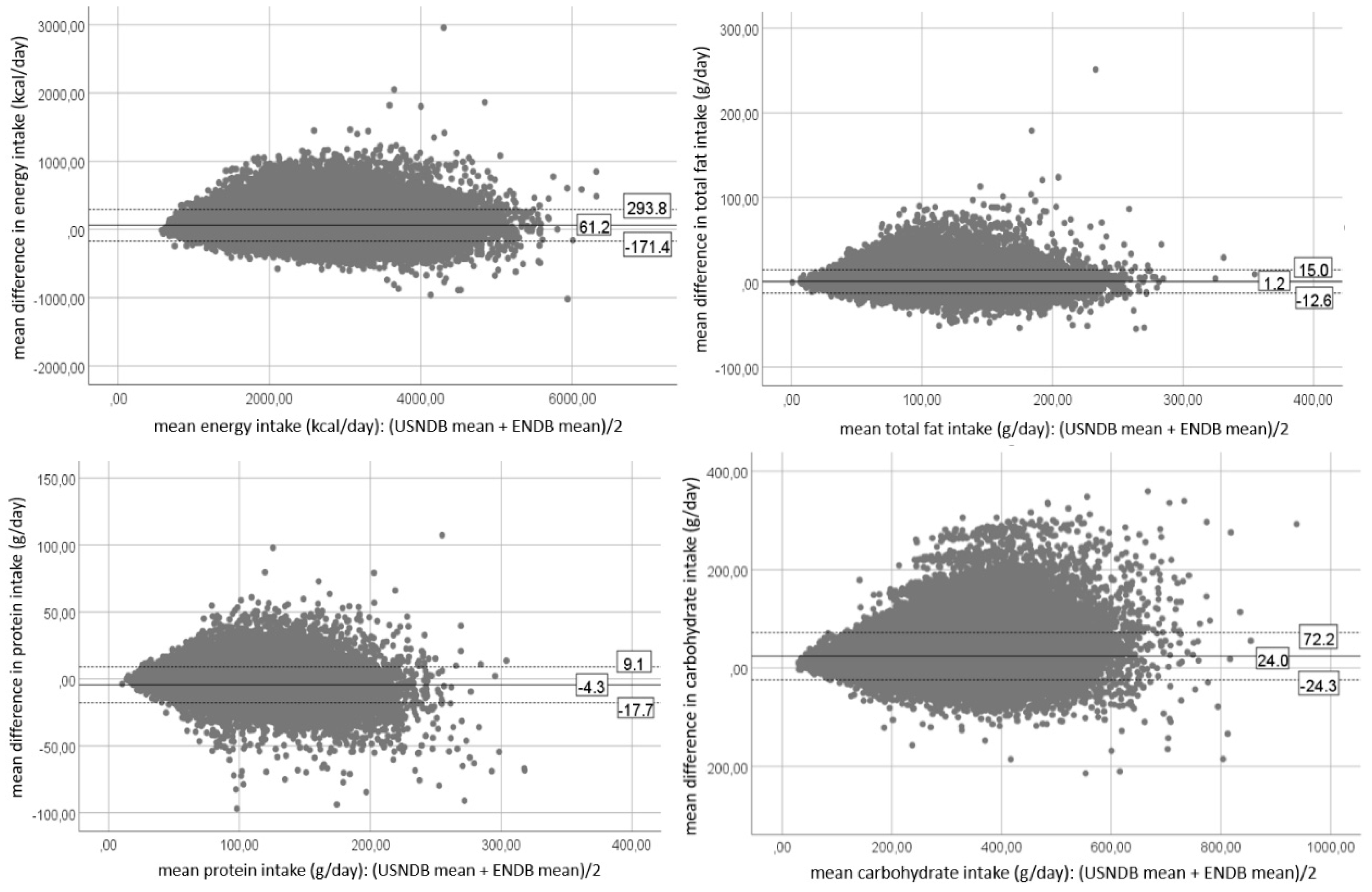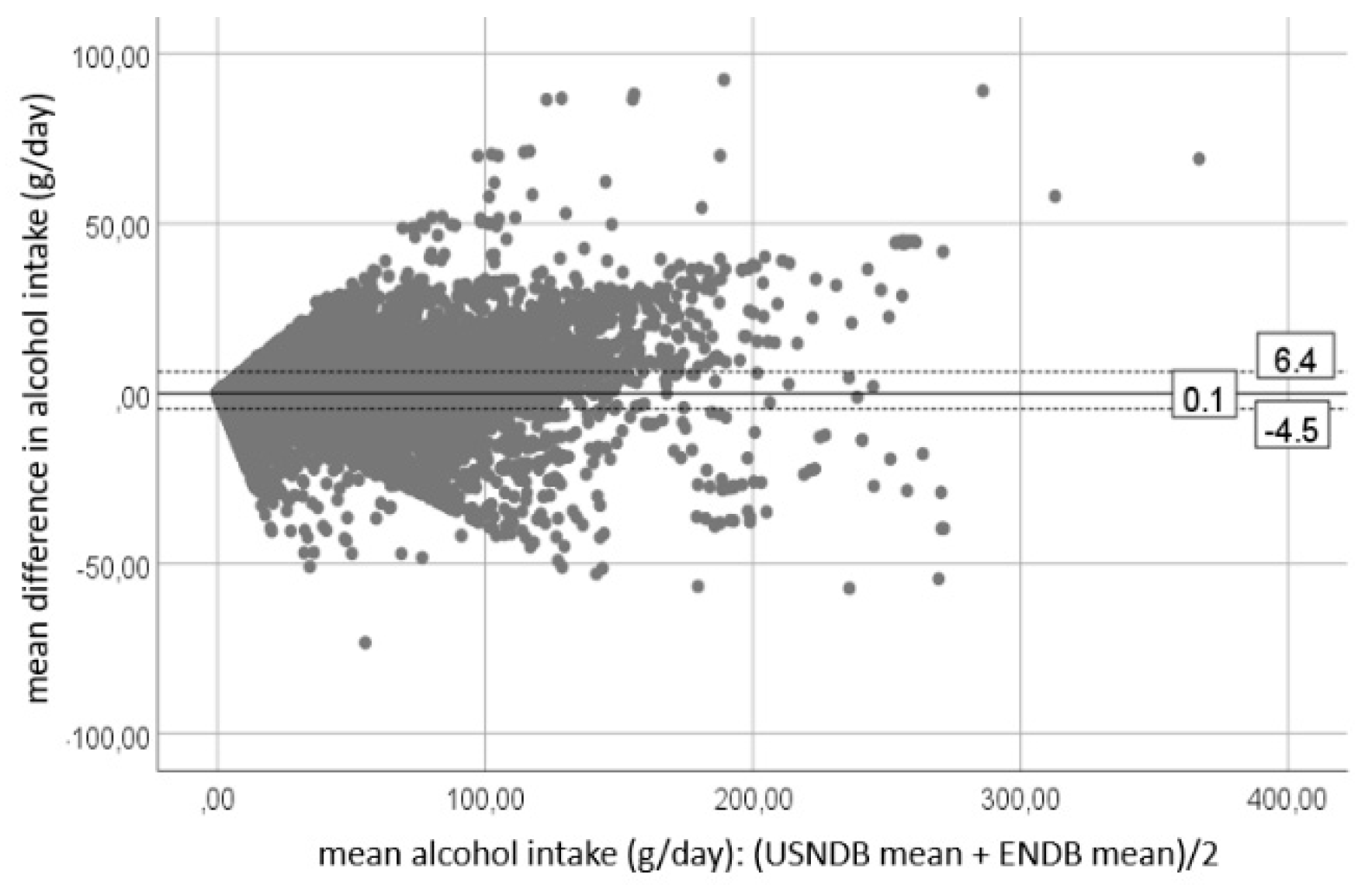Comparing Calculated Nutrient Intakes Using Different Food Composition Databases: Results from the European Prospective Investigation into Cancer and Nutrition (EPIC) Cohort
Abstract
1. Introduction
2. Materials and Methods
2.1. EPIC Study Design
2.2. Dietary Intake Assessment Methods
2.3. Initial Compilation of a Harmonised Nutrient Database for the EPIC Project
2.4. Matching of the EPIC Food List with the USNDB
2.5. Quality Assessment of the Matching Procedure
2.6. Statistical Analyses
3. Results
4. Discussion
4.1. Main Results and Interpretation
4.2. Comparison with Similar Studies
4.3. Recommendations for Future Studies and Food Composition Data Compilers
4.4. Strengths and Limitations of the Comparison Study
4.5. Recommendations for Users of the EPIC Nutrients Database
5. Conclusions
Supplementary Materials
Author Contributions
Funding
Acknowledgments
Conflicts of Interest
Availability of Data and Materials
References
- European Food Information Resource (EuroFIR): What Makes a Food Composition Database (FCDB)? Available online: https://www.eurofir.org/food-information/what-are-fcdbs (accessed on 12 March 2020).
- Slimani, N.; Deharveng, G.; Unwin, I.; Vignat, J.; Skeie, G.; Salvini, S.; Møller, A.; Ireland, J.; Becker, W.; Southgate, D. Standardisation of an european end-user nutrient database for nutritional epidemiology: What can we learn from the epic nutrient database (endb) project? Trends Food Sci. Technol. 2007, 18, 407–419. [Google Scholar] [CrossRef]
- Bell, S.; Pakkala, H.; Finglas, M.P. Towards a european food composition data interchange platform. Int. J. Vitam. Nutr. Res. 2012, 82, 209–215. [Google Scholar] [CrossRef] [PubMed]
- Deharveng, G.; Charrondiere, U.R.; Slimani, N.; Southgate, D.A.; Riboli, E. Comparison of nutrients in the food composition tables available in the nine European countries participating in epic. European prospective investigation into cancer and nutrition. Eur. J. Clin. Nutr. 1999, 53, 60–79. [Google Scholar] [CrossRef] [PubMed]
- Gurinović, M.; Witthöft, C.M.; Tepšić, J.; Ranić, M.; Hulshof, P.J.M.; Hollman, P.C.; Porubska, J.; Gohar, A.; Debeljak-Martačić, J.; Petrović-Oggiano, G.; et al. Capacity development in food composition database management and nutritional research and education in central and eastern european, middle eastern and north african countries. Eur. J. Clin. Nutr. 2010, 64, S134–S138. [Google Scholar] [CrossRef]
- Becker, W. Towards a cen standard on food data. Eur. J. Clin. Nutr. 2010, 64 (Suppl. 3), S49–S52. [Google Scholar] [CrossRef]
- Slimani, N.; Deharveng, G.; Unwin, I.; Southgate, D.; Vignat, J.; Skeie, G.; Salvini, S.; Parpinel, M.; Møller, A.; Ireland, J. The epic nutrient database project (endb): A first attempt to standardize nutrient databases across the 10 european countries participating in the epic study. Eur. J. Clin. Nutr. 2007, 61, 1037–1056. [Google Scholar] [CrossRef]
- Leclercq, C.; Valsta, L.M.; Turrini, A. Food composition issues—Implications for the development of food-based dietary guidelines. Public Health Nutr. 2001, 4, 677–682. [Google Scholar] [CrossRef]
- U.S. Department of Agriculture, Agricultural Research Service. USDA National Nutrient Database for Standard Reference, Release 28. 2015. Documentation and User Guide. 2020. Available online: http://www.ars.usda.gov/ba/bhnrc/ndl (accessed on 20 March 2020).
- Riboli, E.; Hunt, K.; Slimani, N.; Ferrari, P.; Norat, T.; Fahey, M.; Charrondiere, U.; Hemon, B.; Casagrande, C.; Vignat, J. European prospective investigation into cancer and nutrition (epic): Study populations and data collection. Public Health Nutr. 2002, 5, 1113–1124. [Google Scholar] [CrossRef]
- Riboli, E.; Kaaks, R. The epic project: Rationale and study design. European prospective investigation into cancer and nutrition. Int. J. Epidemiol. 1997, 26, 6–14. [Google Scholar] [CrossRef]
- Slimani, N.; Kaaks, R.; Ferrari, P.; Casagrande, C.; Clavel-Chapelon, F.; Lotze, G.; Kroke, A.; Trichopoulos, D.; Trichopoulou, A.; Lauria, C. European prospective investigation into cancer and nutrition (epic) calibration study: Rationale, design and population characteristics. Public Health Nutr. 2002, 5, 1125–1145. [Google Scholar] [CrossRef]
- Slimani, N.; Ferrari, P.; Ocke, M.; Welch, A. Standardization of the 24-hour diet recall calibration method used in the european prospective investigation into cancer and nutrition (epic): General concepts and preliminary results. Eur. J. Clin. Nutr. 2000, 54, 900–917. [Google Scholar] [CrossRef] [PubMed]
- Nicolas, G.; Witthöft, C.M.; Vignat, J.; Knaze, V.; Huybrechts, I.; Roe, M.; Finglas, P.; Slimani, N. Compilation of a standardised international folate database for epic. Food Chem. 2014, 193, 134–140. [Google Scholar] [CrossRef] [PubMed]
- Bouckaert, K.P.; Slimani, N.; Nicolas, G.; Vignat, J.; Wright, A.J.; Roe, M.; Witthöft, C.M.; Finglas, P.M. Critical evaluation of folate data in european and international databases: Recommendations for standardization in international nutritional studies. Mol. Nutr. Food Res. 2011, 55, 166–180. [Google Scholar] [CrossRef] [PubMed]
- Bland, J.M.; Altman, D. Statistical methods for assessing agreement between two methods of clinical measurement. Lancet 1986, 327, 307–310. [Google Scholar] [CrossRef]
- Cohen, J. Weighted kappa: Nominal scale agreement with provision for scaled disagreement or partial credit. Psychol. Bull. 1968, 70, 213–220. [Google Scholar] [CrossRef] [PubMed]
- U.S. Department of Agriculture, Agricultural Research Service. USDA National Nutrient Database for Standard Reference, Release 26. 2013. Documentation and User Guide. Available online: http://www.ars.usda.gov/ba/bhnrc/ndl (accessed on 18 March 2020).
- Hakala, P.; Knuts, L.R.; Vuorinen, A.; Hammar, N.; Becker, W. Comparison of nutrient intake data calculated on the basis of two different databases. Results and experiences from a swedish-finnish study. Eur. J. Clin. Nutr. 2003, 57, 1035–1044. [Google Scholar] [CrossRef]
- Julian-Almarcegui, C.; Bel-Serrat, S.; Kersting, M.; Vicente-Rodriguez, G.; Nicolas, G.; Vyncke, K.; Vereecken, C.; De Keyzer, W.; Beghin, L.; Sette, S.; et al. Comparison of different approaches to calculate nutrient intakes based upon 24-h recall data derived from a multicenter study in european adolescents. Eur. J. Nutr. 2016, 55, 537–545. [Google Scholar] [CrossRef]
- Vaask, S.; Pomerleau, J.; Pudule, I.; Grinberga, D.; Abaravicius, A.; Robertson, A.; McKee, M. Comparison of the micro-nutrica nutritional analysis program and the russian food composition database using data from the baltic nutrition surveys. Eur. J. Clin. Nutr. 2004, 58, 573–579. [Google Scholar] [CrossRef][Green Version]
- Summer, S.S.; Ollberding, N.J.; Guy, T.; Setchell, K.D.R.; Brown, N.; Kalkwarf, H.J. Cross-border use of food databases: Equivalence of us and australian databases for macronutrients. J. Acad. Nutr. Diet. 2013, 113, 1340–1345. [Google Scholar] [CrossRef]
- Garcia, V.; Rona, R.J.; Chinn, S. Effect of the choice of food composition table on nutrient estimates: A comparison between the british and american (chilean) tables. Public Health Nutr. 2004, 7, 577–583. [Google Scholar] [CrossRef]
- European Food Information Resource (EuroFIR): About Us. Available online: https://www.eurofir.org/about_eurofir/ (accessed on 30 March 2020).
- International Network of Food Data Systems (INFOODS): About Infoods. Available online: http://www.fao.org/infoods/infoods/en/ (accessed on 28 May 2020).
- Brussaard, J.H.; Löwik, M.R.H.; Steingrímsdóttir, L.; Møller, A.; Kearney, J.; De Henauw, S.; Becker, W. A European food consumption survey method—Conclusions and recommendations. Eur. J. Clin. Nutr. 2002, 56, S89–S94. [Google Scholar] [CrossRef] [PubMed]




|
|
|
|
| 24-HDR (N = 34,064) | DQ (N = 476,768) | ||||||||
|---|---|---|---|---|---|---|---|---|---|
| Food Component | Database | Mean | Standard Deviation | Median | Mean Difference * | Mean | Standard Deviation | Median | Mean Difference * |
| Energy (kcal/day) | ENDB | 2611.4 | ±905.2 | 2004 | 2071.4 | ±617.3 | 1993.8 | ||
| USNDB | 2596.4 | ±900.3 | 2023 | 20.2 | 2132.6 | ±623.5 | 2057.4 | 61.2 | |
| Water (g/day) | ENDB | 2115.9 | ±789.2 | 2485 | 2259.7 | ±899.3 | 2171.7 | ||
| USNDB | 2136.0 | ±790.5 | 2471 | −15.0 | 2248.4 | ±890.9 | 2157.3 | −11.3 | |
| Total fats (g/day) | ENDB | 85.1 | ±42.7 | 77.7 | 80.1 | ±29.3 | 76.1 | ||
| USNDB | 84.9 | ±41.9 | 77.6 | −0.2 | 81.3 | ±29.6 | 77.5 | 1.2 | |
| Fatty acids, total | ENDB | 33.7 | ±18.8 | 30.3 | 31.3 | ±13.0 | 29.3 | ||
| saturated (g/day) | USNDB | 30.0 | ±16.8 | 26.8 | −3.7 | 28.6 | ±12.2 | 26.7 | −2.7 |
| Fatty acids, total monounsaturated | ENDB | 31.0 | ±17.8 | 27.4 | 28.7 | ±12.2 | 26.6 | ||
| (g/day) | USNDB | 32.5 | ±18.0 | 29.0 | 1.5 | 30.4 | ±12.2 | 28.5 | 1.7 |
| Fatty acids, total polyunsaturated | ENDB | 13.3 | ±9.3 | 10.9 | 13.4 | ±6.0 | 12.2 | ||
| (g/day) | USNDB | 15.6 | ±10.2 | 13.1 | 2.3 | 15.4 | ±6.5 | 14.2 | 2.0 |
| Cholesterol | ENDB | 326.2 | ±229.8 | 269.1 | 321.0 | ±150.5 | 298.1 | ||
| (mg/day) | USNDB | 283.0 | ±200.8 | 234.4 | −43.2 | 283.6 | ±133.4 | 264.7 | −37.5 |
| Total proteins | ENDB | 84.4 | ±34.6 | 79.0 | 86.9 | ±27.4 | 83.9 | ||
| (g/day) | USNDB | 78.3 | ±30.8 | 73.8 | −6.1 | 82.6 | ±25.5 | 79.7 | −4.3 |
| Carbohydrates | ENDB | 227.2 | ±89.4 | 214.5 | 229.7 | ±74.5 | 220.0 | ||
| (g/day) | USNDB | 244.6 | ±97.2 | 230.4 | 17.4 | 253.7 | ±80.6 | 243.4 | 24.0 |
| Sugar, total | ENDB | 104.6 | ±54.1 | 95.3 | 104.2 | ±44.1 | 97.3 | ||
| (g/day) | USNDB | 98.7 | ±54.0 | 89.2 | −5.9 | 102.1 | ±46.1 | 94.3 | −2.0 |
| Starch (g/day) | ENDB | 118.7 | ±57.9 | 109.2 | 122.0 | ±49.0 | 114.4 | ||
| USNDB | 41.9 | ±40.0 | 32.3 | −76.8 | 49.6 | ±32.4 | 42.7 | −72.3 | |
| Dietary fiber, | ENDB | 21.2 | ±9.9 | 19.6 | 22.8 | ±7.8 | 21.8 | ||
| total (g/day) | USNDB | 21.0 | ±10.4 | 19.2 | −0.2 | 23.8 | ±8.6 | 22.6 | 1.0 |
| Alcohol (g/day) | ENDB | 14.8 | ±24.4 | 1.8 | 12.0 | ±16.9 | 5.8 | ||
| USNDB | 15.9 | ±26.1 | 1.3 | 1.0 | 12.9 | ±18.1 | 6.3 | 0.9 | |
| Calcium, Ca | ENDB | 943.3 | ±455.7 | 870.9 | 995.2 | ±411.1 | 935.9 | ||
| (mg/day) | USNDB | 995.0 | ±489.8 | 910.8 | 51.7 | 1079.4 | ±447.9 | 1012.6 | 84.1 |
| Iron, Fe (mg/day) | ENDB | 12.4 | ±6.0 | 11.4 | 12.9 | ±4.2 | 12.4 | ||
| USNDB | 12.2 | ±5.8 | 11.1 | −0.3 | 13.0 | ±4.7 | 12.3 | 0.2 | |
| Potassium, K | ENDB | 3516.3 | ±1256.6 | 3361.4 | 3659.7 | ±1030.9 | 3554.9 | ||
| (mg/day) | USNDB | 3071.6 | ±1101.2 | 2952.8 | −444.7 | 3282.5 | ±949.4 | 3182.4 | −377.2 |
| Magnesium, Mg | ENDB | 355.4 | ±128.8 | 336.8 | 360.4 | ±111.4 | 345.6 | ||
| (mg/day) | USNDB | 325.7 | ±127.9 | 304.9 | −29.7 | 347.2 | ±103.6 | 334.3 | −13.2 |
| Phosphorus, P | ENDB | 1405.9 | ±530.4 | 1333.6 | 1492.1 | ±456.3 | 1439.0 | ||
| (mg/day) | USNDB | 1356.7 | ±525.5 | 1282.8 | −49.2 | 1447.2 | ±446.1 | 1395.1 | −44.8 |
| Vitamin D | ENDB | 4.3 | ±6.4 | 2.4 | 4.3 | ±3.5 | 3.4 | ||
| (µg/day) | USNDB | 3.1 | ±3.9 | 1.9 | −1.3 | 3.4 | ±3.3 | 2.6 | −0.9 |
| Vitamin E (alpha-tocopherol) | ENDB | 11.3 | ±8.1 | 9.3 | 11.7 | ±5.3 | 10.6 | ||
| (mg/day) | USNDB | 9.3 | ±5.9 | 8.0 | −2.1 | 9.8 | ±4.5 | 9.0 | −1.9 |
| Retinol (µg/day) | ENDB | 859.5 | ±1819.0 | 444.5 | 845.7 | ±750.0 | 640.9 | ||
| USNDB | 743.8 | ±1302.5 | 466.4 | −115.7 | 746.7 | ±587.6 | 603.9 | −99.0 | |
| Beta-carotene | ENDB | 2852.2 | ±3845.7 | 1555.0 | 3506.5 | ±2773.6 | 2802.4 | ||
| (µg/day) | USNDB | 2964.8 | ±4219.4 | 1452.5 | 112.6 | 3961.3 | ±3006.2 | 3250.1 | 454.8 |
| Thiamin, B1 | ENDB | 1.2 | ±0.6 | 1.1 | 1.3 | ±0.5 | 1.3 | ||
| (mg/day) | USNDB | 1.7 | ±1.0 | 1.5 | 0.5 | 1.8 | ±0.7 | 1.7 | 0.5 |
| Riboflavin, B2 | ENDB | 1.7 | ±0.8 | 1.6 | 1.9 | ±0.8 | 1.7 | ||
| (mg/day) | USNDB | 2.2 | ±0.9 | 2.1 | 0.6 | 2.3 | ±0.8 | 2.2 | 0.4 |
| Cobalamin, B12 | ENDB | 6.4 | ±9.8 | 4.3 | 6.6 | ±4.1 | 5.8 | ||
| (µg/day) | USNDB | 6.6 | ±8.8 | 4.7 | 0.2 | 7.0 | ±4.0 | 6.2 | 0.3 |
| Vitamin B6 | ENDB | 1.7 | ±0.8 | 1.6 | 1.9 | ±0.6 | 1.8 | ||
| (µg/day) | USNDB | 1.9 | ±0.9 | 1.7 | 0.1 | 2.0 | ±0.7 | 1.9 | 0.2 |
| Vitamin C | ENDB | 112.0 | ±89.6 | 90.0 | 122.4 | ±63.8 | 110.6 | ||
| (mg/day) | USNDB | 103.7 | ±94.6 | 76.6 | −8.2 | 116.3 | ±66.9 | 102.8 | −6.0 |
| Folate, food | ENDB | 264.6 | ±137.0 | 137.0 | 305.0 | ±120.0 | 284.7 | ||
| (µg/day) | USNDB | 328.4 | ±156.9 | 141.7 | 11.8 | 304.9 | ±110.7 | 290.1 | −0.2 |
| 24-HDR (N = 34,064) | DQ (N = 476,768) | |||
|---|---|---|---|---|
| Pearson Correlation Coefficient * | Weighted κ | Pearson Correlation Coefficient * | Weighted κ | |
| Energy (kcal/day) | 0.96 | 0.83 | 0.98 | 0.89 |
| Water (g/day) | 1.00 | 0.96 | 1.00 | 0.98 |
| Total fats (g/day) | 0.94 | 0.80 | 0.97 | 0.86 |
| Fatty acids, total saturated (g/day) | 0.89 | 0.73 | 0.93 | 0.78 |
| Fatty acids, total monounsaturated (g/day) | 0.91 | 0.73 | 0.95 | 0.80 |
| Fatty acids, total polyunsaturated (g/day) | 0.83 | 0.65 | 0.88 | 0.69 |
| Cholesterol (mg/day) | 0.87 | 0.72 | 0.91 | 0.75 |
| Total proteins (g/day) | 0.93 | 0.76 | 0.97 | 0.84 |
| Carbohydrates (g/day) | 0.92 | 0.78 | 0.95 | 0.83 |
| Sugar, total (g/day) | 0.91 | 0.77 | 0.93 | 0.82 |
| Starch (g/day) | 0.54 | 0.30 | 0.72 | 0.43 |
| Dietary fiber, total (g/day) | 0.85 | 0.69 | 0.93 | 0.77 |
| Alcohol (g/day) | 0.98 | 0.82 | 0.99 | 0.96 |
| Calcium, Ca (mg/day) | 0.87 | 0.70 | 0.90 | 0.72 |
| Iron, Fe (mg/day) | 0.71 | 0.56 | 0.84 | 0.66 |
| Potassium, K (mg/day) | 0.91 | 0.75 | 0.97 | 0.84 |
| Magnesium, Mg (mg/day) | 0.76 | 0.59 | 0.78 | 0.63 |
| Phosphorus, P (mg/day) | 0.89 | 0.73 | 0.92 | 0.77 |
| Vitamin D (µg/day) | 0.48 | 0.41 | 0.83 | 0.49 |
| Vitamin E (alpha-tocopherol) (mg/day) | 0.70 | 0.53 | 0.62 | 0.50 |
| Retinol (µg/day) | 0.74 | 0.74 | 0.81 | 0.74 |
| Beta-carotene (µg/day) | 0.90 | 0.69 | 0.90 | 0.72 |
| Thiamin, B1 (mg/day) | 0.56 | 0.54 | 0.78 | 0.60 |
| Riboflavin, B2 (mg/day) | 0.81 | 0.57 | 0.88 | 0.66 |
| Cobalamin, B12 (µg/day) | 0.87 | 0.61 | 0.90 | 0.69 |
| Vitamin B6 (mg/day) | 0.79 | 0.64 | 0.86 | 0.72 |
| Vitamin C (mg/day) | 0.93 | 0.78 | 0.97 | 0.85 |
| Folate, food (µg/day) | 0.78 | 0.63 | 0.88 | 0.72 |
© 2020 by the authors. Licensee MDPI, Basel, Switzerland. This article is an open access article distributed under the terms and conditions of the Creative Commons Attribution (CC BY) license (http://creativecommons.org/licenses/by/4.0/).
Share and Cite
Van Puyvelde, H.; Perez-Cornago, A.; Casagrande, C.; Nicolas, G.; Versele, V.; Skeie, G.; B. Schulze, M.; Johansson, I.; María Huerta, J.; Oliverio, A.; et al. Comparing Calculated Nutrient Intakes Using Different Food Composition Databases: Results from the European Prospective Investigation into Cancer and Nutrition (EPIC) Cohort. Nutrients 2020, 12, 2906. https://doi.org/10.3390/nu12102906
Van Puyvelde H, Perez-Cornago A, Casagrande C, Nicolas G, Versele V, Skeie G, B. Schulze M, Johansson I, María Huerta J, Oliverio A, et al. Comparing Calculated Nutrient Intakes Using Different Food Composition Databases: Results from the European Prospective Investigation into Cancer and Nutrition (EPIC) Cohort. Nutrients. 2020; 12(10):2906. https://doi.org/10.3390/nu12102906
Chicago/Turabian StyleVan Puyvelde, Heleen, Aurora Perez-Cornago, Corinne Casagrande, Geneviève Nicolas, Vickà Versele, Guri Skeie, Matthias B. Schulze, Ingegerd Johansson, José María Huerta, Andreina Oliverio, and et al. 2020. "Comparing Calculated Nutrient Intakes Using Different Food Composition Databases: Results from the European Prospective Investigation into Cancer and Nutrition (EPIC) Cohort" Nutrients 12, no. 10: 2906. https://doi.org/10.3390/nu12102906
APA StyleVan Puyvelde, H., Perez-Cornago, A., Casagrande, C., Nicolas, G., Versele, V., Skeie, G., B. Schulze, M., Johansson, I., María Huerta, J., Oliverio, A., Ricceri, F., Halkjær, J., Amiano Etxezarreta, P., Van Herck, K., Weiderpass, E., J. Gunter, M., & Huybrechts, I. (2020). Comparing Calculated Nutrient Intakes Using Different Food Composition Databases: Results from the European Prospective Investigation into Cancer and Nutrition (EPIC) Cohort. Nutrients, 12(10), 2906. https://doi.org/10.3390/nu12102906






